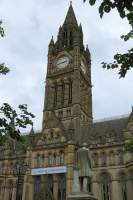
The Town Hall, erected between 1868 and 1877 (the coats of arms bear the dates 1873 and 1874 on the front and Cooper St sides), has been well described elsewhere on many occasions, and we shall note here only the skill of the architect, Alfred Waterhouse, in designing such a magnificent building on a triangular site, with its soaring clock tower and complex and satisfying skyline, before turning to the sculptural decorations that are the principal concern of these pages. But in looking at the details, we should not forget to view the building from a distance too, to appreciate the dominating presence of the finest of all Victorian town halls.
The stone statues, mostly on the front of the building towards the Square, show nobles and knights and priests and rulers considered of most historical significance to Manchester and the eminence of Lancashire more broadly, though the choice of whom to include was much debated. The sculptors were the prolific firm of Farmer and Brindley, always highly competent and assured, and sometimes rising to rank among the best of architectural sculptors, as examination of some of these statues demonstrates. There are two main groupings of figures, and some more isolated ones:
St George, Henry III, Elizabeth I, Agricola.



Around the grand entrance from Albert Square, are: St George at the top of the upper gable to the great portico, hence about four stories up, with hands resting on his shield, recognisable by his cross, but without dragon; beneath the gable at 3rd floor level, niches containing Henry III and Elizabeth I – she recognisable, he, with his inscription gone, could be any early king; and below them, at the top of the lower gable immediately above the porch, is the Emperor Agricola, who established Roman Mancunium, one hand on sword hilt, the other on his shield.
De Gresley, Delawarr (De La Warr), Bradford, Worsley, Chetham, and the Duke of Lancaster.





A second group of six statues, the best ones, are to the left as we look at the building, wrapping round the corner to Princess Street, so we can only see four from the front plus one profile. From left to right they are inscribed Robert De Gresley, Delawarr (De La Warr), Bradford, Worsley, Chetham, and the Duke of Lancaster. Best of all is the last of these, the heroic and noble figure of the Duke of Lancaster. He stands in full plate armour, cloak swept back to free his sword arm, the sword drawn, shield on the other arm, poised turning to the left and with his back tilted slightly backwards, looking downwards, conveying a sense of restrained power. The figure of Robert de Gresley, Baron of Manchester, is also a particularly epic figure, in Crusader garb, and holding, presumably, the Magna Carta which he and his fellow barons compelled King John to sign. The Public Monuments and Sculpture Association state this figure is actually Thomas de Gresley, in which case the document would be the charter of Manchester – the PMSA are very scholarly, so it may be that the inscription decayed and was recut wrongly at a later date. Regardless of identities, all of the figures deserve examination – Bradford for his massed drapery, the dashing figure of Worsley, the calmer, priestly De La Warr, and Chetham with a model of the school he founded.
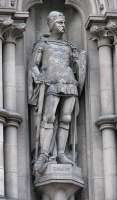
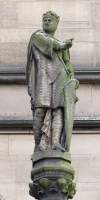 Edward III, and Edward the Elder.
Edward III, and Edward the Elder.
The remaining statues include: Edward III in a niche of his own towards Princess Street – another grand statue of a knight, with a small coronet on his helm, chased decorations on his chest, and ornamental lions’ heads on belt and sword hilt, as befits his kingly status; Edward the Elder (Edward the Saxon) on the porch gable to Cooper Street, wearing chain mail, one hand swept back across his chest, the other resting on his shield; and high up on the tower above the clock faces, unnoticed by almost everyone, are male and female angels. As well as these full figures, which so far have all been Farmer and Brindley, there is a roundel enclosing a panel by Woolner (whom we met in the statue of Bishop Fraser in the Square), entitled Weaving; the companion piece, Spinning, was removed and is apparently inside the building. Woolner shows the weaver seated, turned away from the viewer, and though presumably an 18th century scene – he is an artisan rather than an industrial weaver – the composition has been given a rather medieval feel, and the figure would be too large for his space were he to stand up.
The minor sculptural decoration is also excellent, clearly designed by Waterhouse rather than a sculptor, and reminiscent of the (much more prevalent) detailing on and in the Natural History Museum in London. High up at angel height are dragon heads on snakey necks, there are miniature dragons and eagles as architectural termini and as a pendant in the main entrance, and a lot of leafy designs, mostly around the arches and, most attractively, at the tops of the pillars. Though stylised, these latter retain a certain naturalism, and are so varied that we can envisage Waterhouse regretted that he did not have even more pillars to decorate.
Sculptural details: beasts, vegetation and Coat of Arms.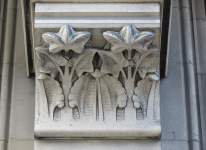
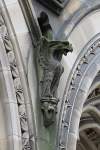
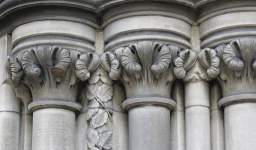
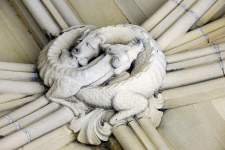
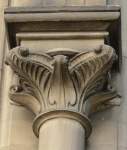
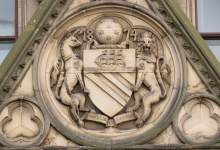
The interior of the building is visitable, in part, and contains several statues and a range of busts. The best of the statues are right inside the entrance, being the eminent scientists Joule and Dalton. Joule is by Alfred Gilbert, and shows the subject with broad face, broadened further by his beard, seated cross legged in a chair and enveloped by a huge cloak. He stares contemplatively, and I always think almost sadly, at a small mechanism in his hand. Facing it is Francis Chantrey’s statue of John Dalton, also seated cross legged, holding a heavy book. Rather cooler in tone, and typical of Chantrey’s poses of seated figures, with low backed chairs covered with drapery – the Watt Memorial in Handsworth, James Northcote in Exeter, Henry Bathurst in Norwich, Joseph Banks in Waterhouse’s Natural History Museum, to name but a few.
The busts used to be seen at leisure in a room of their own, and are of interest because they include examples of portraiture by several eminent Victorian sculptors: Warrington Wood (Joseph Heron, Romaine Callender), Patric Park (Rowland Hill etc), William Theed the Younger (Rowland Hill again), E. G. Papworth (Richard Cobden), Matthew Noble (a young Queen Victoria, Cromwell, Thomas Goadsby), Onslow Ford (Charles Halle), and H. S. Leifchild (George Wilson), as well as a bronze panel by I know not whom with a figure of Britannia with a lion at one side of the globe, Canadian native Americans on the other, and a small aeroplane flying between, commemorating Sir John Alcock and Sir Arthur Whitten Brown, Manchester men who made the first non-stop flight to America in 1919. The busts are still there, by and large, but have been moved to the sides of the room to make way for a café, which while the motives are understandable, and the encouragement of people to enter the building commendable, makes it difficult to appreciate the sculpture as well as previously.
Albert Square // Coroner's Court and Fire Station sculpture // Manchester Cathedral
Sculpture in some towns in England // Sculptors
Visits to this page from 13 Mar 2014: 10,291